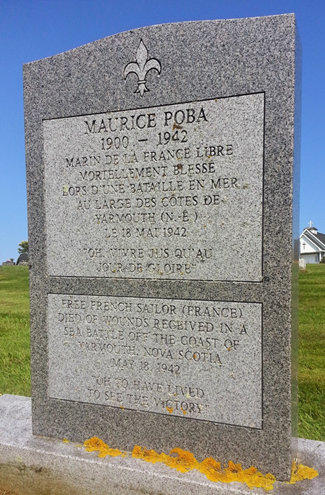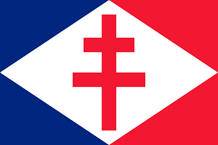
copyright © Wartime Heritage Association
Website hosting courtesy of Register.com - a web.com company
Wartime Heritage
ASSOCIATION
Remembering World War II
Name:
Maurice Poba
Rank:
Seaman, 2nd Cook
Service:
Free French Naval Forces,
SS Fort Binger (London),
Merchant Navy
Date of birth:
Approximately 1900
Place of birth:
Mayumba, South West Africa
(Modern-day Gabon)
Date of Death:
May 18, 1942
Age at Death:
42
Cemetery:
Our Lady of Calvary Cemetery,
Yarmouth, Nova Scotia
Commemorated on the Merchant Seamen's Memorial (Second World War) at the Tower Hill Memorial in London, England
Little is known about Maurice’s family or personal life except that he was
a black man, born in the year 1900 (approximately), in French Equatorial
Africa. Based on his surname he was likely from an ethnic group known
as the Vili people.
Records indicate he was born in Mayumba which is in South West Africa in
Gabon. Other records show his birth place as Senegal, and there is a
‘Mayamba’ in current-day Gambia which is surrounded on all sides by
Senegal. But - Mayumba, Gabon is more likely.
Maurice was 5 feet, 10 inches high and weighed 69 kg (152 lbs.) in 1942.
It is not known exactly when Maurice began serving in the French
merchant navy but eventually, he would find himself in the SS Fort
Binger, a 5250-gross-ton freighter serving in French West Africa.
The Binger was seized by the British Ministry of War Transport at Douala, Cameron on August 29, 1940. The ship
was used to ferry Free French troops to Port Sudan from December 1940 to May of 1941.
The Binger’s crew, mastered by Captain Andre Jean Jacques Joly, included 61
officers and men now serving as Free French, fighting against the Nazi-backed
collaborationist Vichy government established in southern France.
Based on New York port records, it appears Maurice Poba and the SS Fort Binger
made a successful Atlantic crossing in March of 1942, arriving in New York
March 17.
Two months later, in May of 1942, The SS Fort Binger was attached to Convoy ON 92 with over 40 ships, protected
by 4 Royal Canadian Navy corvettes (HMCS Algoma, HMCS Arvida, HMCS Bittersweet, and HMCS Shediac) along
with a US Navy destroyer, the USS Gleaves, and a US Coast Guard cutter, the USCGC Spencer.
The convoy departed Liverpool May 6th, with the group of over 42 ships coalescing off of the Isle of Islay,
Scotland before departing as a group across the Atlantic May 7th. The convoy did not cross the Atlantic without
trouble. Wolfpack Hecht located the convoy a few days into the crossing and over the course of 3 days, 7 ships
were lost. The remainder of the convoy continued on to Halifax, NS; arriving May 21, 1942.
Although the Binger also departed Liverpool on May 6th, it stopped in Belfast, Northern Ireland the following day
in order to land an ill crew member - until May 8th, then sailed for New York. As a result, the ship fell out of
convoy and had to sail alone, unescorted.
By the night of May 17th, the ship had left the dangerous open expanse of the Mid-Atlantic behind, but was less
than a third of the way across the mouth of the Gulf of Maine, between Cape Sable Nova Scotia and Cape Cod,
Massachusetts. It was roughly 60 miles south of Yarmouth, Nova Scotia in roughly 600 feet of water.
Though it was a very dark night, a battle between lookouts of the SS Fort Binger and a nearby German submarine
ensued after roughly 10:05 pm local time on the 17th, with the eager eyes on U-boat U-588 detecting the ship
and the sub’s skipper Victor Vogel sending two well-aimed torpedoes in the direction of Binger. The Germans
were however, outwitted by the Free French, whose lookouts managed to see and anticipate the torpedoes off
the port bow. The ship jammed the rudder left to turn to port, with the result that a torpedo passed harmlessly
astern and another caused just a glancing blow off the port bow.
Fort Binger’s crew, now fully alert, manned their guns and a surface battle ensued.
The ship passed over the firing position in an attempt to ram the submerged U-boat, which surfaced 20 minutes
later and opened fire with the deck gun from a distance of about a half mile.
In all, reports state up to 50 rounds were fired at the Binger, with 7 hitting the ship. No serious damage was
done but the shells and shrapnel killed one man - the Second Cook of the SS Fort Binger – Maurice Poba, and
wounded four other crew members.
The ship stopped briefly after a hit near the boiler room, but then proceeded after sending distress signals and
returned fire with the 4-inch stern gun (SS Fort Binger was also armed with six machine guns), firing four rounds
which all fell short. After U-588 scored a few more hits on the bridge and the side of the ship, the Fort Binger
turned around in another attempt to ram the attacker but failed to build up speed due to damaged steam pipes
and then headed towards Nova Scotia.
Other accounts state while the freighter maneuvered frantically, trying to ram the U-boat, U-588’s deck gunners
fired at least seven shells into the ship without serious effect and that when the range opened sufficiently to
allow Binger’s single, four-inch gun to bear, its crew placed four rounds close enough to force Vogel, the U-boat
captain, to submerge.
In the Madera Tribune (a California paper) of May 19, 1942, it was explained that the Binger waited until the U-
boat was within 100 yards of their ship until the crew opened up with their deck gun. It was reported
optimistically by the Fort Binger’s captain that he believed they scored a direct hit, because the U-boat
disappeared in the darkness.
Closer to the coast, fog set it and the U-boat lost contact with the ship at a position of 43°12N/67°05W.
Fort Binger headed for Yarmouth and anchored near the coast in the reduced visibility to repair the steam pipes.
A lifeboat with six men commanded by the second officer was sent to the harbor for medical assistance, and
Yarmouth’s RCAF crash boat, the Arresteur (M-305), brought a doctor to the ship who cared for the wounded until
Binger could dock at Yarmouth at 4:30 pm on May 18, 1942.
Maurice Poba was laid to rest in the Catholic Cemetery, Our Lady of Calvary, in Yarmouth.
The incident triggered a full search for U-588 and it would later become known that she was spotted on the
surface the following day, May 19, by the British SS Ocean Honour.
U-588 had survived the encounter SS Fort Binger engagement, but less than three months later, the U-Boat was
destroyed with all hands July 31, 1942, by HMCS Wetaskiwin and the Skeena.
Sadly, a second crew member of the SS Fort Binger, French Messman Hervé (Edward) Girardin (Born in Saint
Pierre, Saint-Pierre-et-Miquelon on March 19, 1893), died June 17, 1942 (age 49) while in port in New York at
Pier 19 when he accidentally fell through a hatch on the ship into the No., 3 hold. He is buried at St. Peters
Cemetery, in NY (his burial records record his name as Edward Girarden and Edouard Girardin)
Madera Tribune:
“MERCHANT SHIP BATTLED DIVER Gun Battle Followed Failure of Torpedoes to Reach Their Mark
AN EASTERN CANADIAN PORT, May 19 — A shell-battered merchant ship, manned by a free-French crew, has
limped into port here after a three-hour running battle with a submarine, in which she dodged three torpedoes,
withstood a hail of gunfire and scored a direct hit on her attacker. One sailor lost his life and four were wounded
by shrapnel during the shelling attack. In the dead of night, a lookout spotted the white trail of a torpedo heading
toward the ship. The helm was thrown hard over, and the torpedo hit the bow a glancing blow, failing to explode.
A second and third torpedo were dodged similarly. One narrowly missed the stern, while the last glanced off the
bow, and like the first, failed to explode. The U-boat then surfaced and swung her deck guns on the ship, sending
10 shells into her superstructure, smashing the bridge and raining the deck with shrapnel. During this attack
Seaman Maurice Poba was killed and the others wounded. The undersea raider then raked the deck with machine
gun fire.”
Maurice Poba





Gabon, Africa


Merchant Seaman rescued from other ships lost in Convoy ON92, aboard HMCS Shediac, May 1942
Sources:
ericwiberg.com
Madera Tribune, Number 68, 19 May 1942
Legion Magazine
www.uboat.net
In U-Boats Against Canada: German Submarines in Canadian Waters by Michael L. Hadley


- World War I - Menu
- WWI Stories and Articles
- Photos - Yarmouth Soldiers
- Selection of World War I Songs
- WWI Casualties of Yarmouth, NS
- Those Who Served - Yarmouth, NS
- WWI Casualties Digby Co. NS
- WWI Casualties Shelburne Co. NS
- Merchant Mariners (1915) Yarmouth, NS
- Canadian Forestry Corps - Non Yarmouth Birth/Residence Enlistments
- US Draft Registry - Yarmouth NS Born


- World War II - Menu
- WWII Stories and Articles
- Telegraphist Air Gunners
- WWII Casualties of Nova Scotia
- US Casualties with NS Connection
- Far East/Pacific Casualties with NS Connection
- Merchant Navy Casualties Nova Scotia
- Nova Scotia WWII Casualties Holten Canadian War Cemetery
- D-Day Casualties - Nova Scotia
- CANLOAN Program Casualties - Nova Scotia
- Battle of the Bulge Casualties - Nova Scotia
- WWII Casualties Yarmouth NS
- Yarmouth Casualties - RCAF RAF Canadian Army WWII
- Yarmouth Co., Marriages WWII
- Casualties Non-Born/Residents with Connection to Yarmouth Co., Nova Scotia.
- WWII Casualties Digby Co., NS
- Non-Nova Scotian WWII Casualties Buried in Nova Scotia
- WWII RCAF Casualties Aged 16-18
- Brothers/Sisters Who Served - World War II













